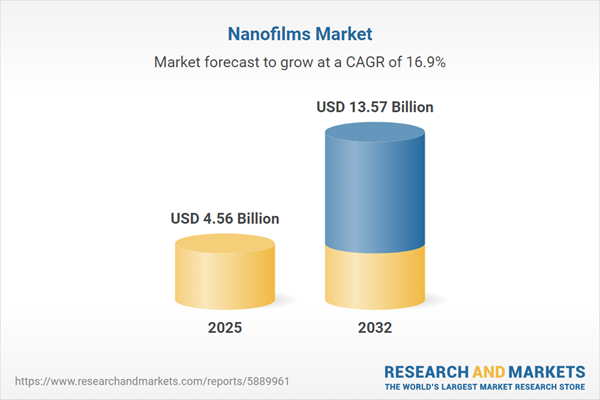Speak directly to the analyst to clarify any post sales queries you may have.
The nanofilms market is rapidly transforming global industries, driven by technological advancements, innovation in deposition techniques, and broadening applications across automotive, electronics, construction, and healthcare sectors.
Market Snapshot: Nanofilms Market Growth and Trends
The nanofilms market grew from USD 3.89 billion in 2024 to USD 4.56 billion in 2025, with expectations of a continued CAGR of 16.90%, reaching USD 13.57 billion by 2032. This notable expansion reflects the increasing adoption of ultra-thin coatings for functionality enhancement and protection across a diverse set of industries. As companies harness advanced materials and edge closer to large-scale commercial deployment, the demand for tailored nanofilm solutions is rising, supported by breakthroughs in material science and novel manufacturing processes.
Scope & Segmentation
- Type: Anti Corrosion, Anti Fog, Anti Scratch, Protective Coatings (including Chemical Resistant, Scratch Resistant, Wear Resistant), Ultraviolet.
- Application: Automotive, Construction, Electronics & Semiconductor (including Display, Integrated Circuit, Sensor), Healthcare & Medical, Packaging.
- Material: Ceramic Nanofilm, Hybrid Nanofilm, Metal Oxide Nanofilm, Polymer Nanofilm.
- Thickness: Thick, Thin, Ultra Thin.
- Deposition Technique: Atomic Layer Deposition (Plasma ALD, Thermal ALD), Chemical Vapor Deposition (Plasma Enhanced CVD, Thermal CVD), Layer-Layer Assembly, Physical Vapor Deposition (Evaporation, Sputtering), Sol-Gel Coating.
- Geography: Americas (including United States, Canada, Mexico, Brazil, Argentina, Chile, Colombia, Peru), Europe, Middle East & Africa (including United Kingdom, Germany, France, Russia, Italy, Spain, Netherlands, Sweden, Poland, Switzerland, United Arab Emirates, Saudi Arabia, Qatar, Turkey, Israel, South Africa, Nigeria, Egypt, Kenya), Asia-Pacific (including China, India, Japan, Australia, South Korea, Indonesia, Thailand, Malaysia, Singapore, Taiwan).
- Key Companies Profiled: 3M Company, DuPont de Nemours, Inc., Dow Inc., Covestro AG, BASF SE, Eastman Chemical Company, Toray Industries, Inc., LG Chem Ltd., SKC Co., Ltd., Solvay S.A.
Key Takeaways
- The primary keyword, nanofilms market, anchors this report, assisting decision-makers in targeting high-value opportunities across end-use segments.
- Material innovations, such as ceramic and hybrid nanofilms, enable tailored features for specialized applications and are increasingly prevalent in mainstream manufacturing environments.
- Next-generation deposition techniques streamline production, enhancing film uniformity and enabling the cost-effective scaling of sophisticated coatings suited to evolving industry demands.
- Environmental regulations motivate organizations to shift toward eco-conscious processes, supporting sustainability goals while maintaining competitive performance benchmarks.
- Advanced process monitoring and digital manufacturing are minimizing defects and improving yield, granting competitive advantage to agile manufacturers adapting to quality and compliance pressures.
Tariff Impact and Competitive Dynamics
- Recent trade measures in the United States have catalyzed supply chain shifts and cost assessments, urging manufacturers to forge partnerships with regional suppliers and realign production to minimize import dependencies.
- The resulting geographic redistribution of production is fostering new collaboration models, such as joint ventures and licensing agreements, to secure access to essential precursor materials and technical expertise.
- Effective risk management, including scenario planning and procurement diversification, supports business continuity as tariff policies evolve and global trade tensions persist.
Methodology & Data Sources
The analysis utilizes a mixed-method research framework combining interviews with executive leaders, scientists, and engineers with secondary research from peer-reviewed publications, patent filings, and trade data. Quantitative and qualitative findings are validated through cross-referencing and expert workshops, ensuring data reliability and up-to-date insights. The approach incorporates regional trade flow analysis and a comprehensive review of policy and regulatory shifts influencing adoption.
Why This Report Matters
- Gain informed insight into high-growth segments, enabling precise investment and resource allocation strategies.
- Understand evolving regulatory, material, and technology trends to future-proof product portfolios and align operations worldwide.
- Benefit from a data-driven evaluation of emerging supply chain and partnership models—vital for ensuring resilience and consistent access to advanced deposition technologies.
Conclusion
This report is a resource for executive leaders seeking actionable guidance within the global nanofilms landscape. Stakeholders equipped with these insights can maximize growth, manage risk, and position their organizations for sustainable market leadership.
Additional Product Information:
- Purchase of this report includes 1 year online access with quarterly updates.
- This report can be updated on request. Please contact our Customer Experience team using the Ask a Question widget on our website.
Table of Contents
3. Executive Summary
4. Market Overview
7. Cumulative Impact of Artificial Intelligence 2025
Companies Mentioned
The companies profiled in this Nanofilms market report include:- 3M Company
- DuPont de Nemours, Inc.
- Dow Inc.
- Covestro AG
- BASF SE
- Eastman Chemical Company
- Toray Industries, Inc.
- LG Chem Ltd.
- SKC Co., Ltd.
- Solvay S.A.
Table Information
| Report Attribute | Details |
|---|---|
| No. of Pages | 190 |
| Published | November 2025 |
| Forecast Period | 2025 - 2032 |
| Estimated Market Value ( USD | $ 4.56 Billion |
| Forecasted Market Value ( USD | $ 13.57 Billion |
| Compound Annual Growth Rate | 16.9% |
| Regions Covered | Global |
| No. of Companies Mentioned | 11 |









